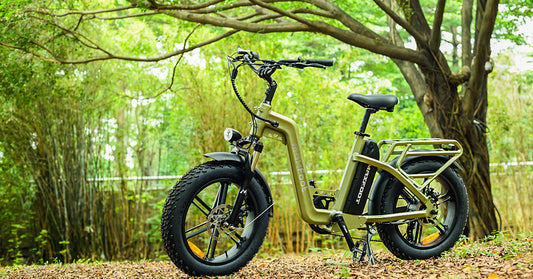E-bikes, with their blend of practicality and speed, are no longer an uncommon sight on our roads. What sets these modern marvels apart from traditional vehicles is the way their speed and performance are measured - not by horsepower, but by the wattage of their motors. You'll see them in varieties of 250 W, 500 W, 750 W, and even 1000 W. It leads to an intriguing question: How fast can a 1000 W powerhouse of an e-bike zip along?
Cutting to the chase, under ideal conditions, a 1000w e-bike can potentially hit up to 28 mph (45 kph) on a flat stretch. However, this is just one piece of the broader e-bike picture. Factors such as the bike's design, tire pressure, and battery health can cause this number to fluctuate.
We'll delve deeper into these nuances later in the article. And to give you real-world insight, we'll share the experience of Maxfoot MF-19, a popular 1000 W folding electric bike, and tell you exactly how fast it can navigate the open road.
What does 1000 W Mean for an Electric bike?
Watt is a unit of power i.e. how much energy an object can deliver per unit time. In the context of an electric bike, the "1000W" figure represents the output power of the electric motor. This indicates that the bike is equipped with a motor, capable of delivering 1000 joules of energy per second.
The wattage of an eBike's motor is a key factor in determining the bike's overall performance, impacting both its speed and its ability to navigate different terrains. A 1000W eBike motor is at the higher end of the power scale for commercially available eBikes. To put it into perspective, many common eBike models range between 250W and 750W.
A higher wattage means that the motor can provide more power, which can in turn lead to higher speeds, better acceleration, and improved ability to tackle hills or rough terrain. This makes a 1000W eBike particularly suited for uses such as off-road biking, heavy cargo transportation, or for individuals who live in hilly areas.
On the flip side, a higher wattage also means higher energy consumption. That means a higher powered motor will consume battery earlier, leading to a short travel range between charges. So, for individuals who primarily use their eBike for short commutes on flat terrain, a lower wattage (and thus lower energy consumption) might be more efficient.
Legal Speed Limit of 1000 W Electric Bikes in the US
In the United States, federal law defines an e-bike as a bicycle that has a motor with a maximum power of 750 watts (1 horsepower), and that can't go faster than 20 mph on level ground without pedaling.
However, the laws governing the use of eBikes are not solely determined at the federal level; they can vary from state to state. For instance, some states might allow eBikes with powerful motors (Virginia, Oregon, Oklahoma), while others might not. Make sure to check your state regulations before buying one.
Is a 1000 W motor enough for Ebike?
Whether a 1000W eBike is "good" or not depends largely on the needs of the user. For those needing to travel longer distances, tackle challenging terrains, or carry heavy loads, a 1000W eBike could be an excellent choice.
For those using the eBike for short, flat commutes, a lower-wattage eBike, probably 750 W or 500W could be more efficient and economical.
As discussed earlier, some regions limit the maximum wattage or speed for eBikes, and a 1000W eBike may exceed these limits. Always ensure your eBike complies with local laws to avoid potential legal issues.
Top Speed Of Maxfoot MF-19: A 1000 W Folding Electric Bike
The Maxfoot MF-19 1000W Electric Folding Bike is a powerful, rugged, and versatile eBike designed for a variety of terrains and uses. Its highlighting feature is its potent 1000W brushless geared motor. This high-powered motor provides the eBike with the ability to tackle various terrains and steep inclines, offering a top speed that could reach up to 23 mph under optimal conditions.
The MF-19's foldable frame is a significant advantage for storage and transportation. It means the bike can be compacted and fit into smaller spaces, such as a car trunk, or stored away neatly when not in use.
With full suspension (front and rear), the MF-19 is built to absorb shock effectively. This feature ensures a smooth and comfortable ride, even on rough terrains. It is powered by a high-capacity 48V 14AH battery, which can offer a considerable range per charge.
How far can a 1000 W Ebike go?
The mileage of the bike is dependent on the battery size. Let’s consider the case of Maxfoot MF-19. It bears a 48 V 14 AH batter and a top speed of 23 mph.
First, we calculate the watt-hours of this ebike. That is the product of voltage and ampere-hours.
On average, an ebike requires about 15 Wh of energy to travel one mile. Considering the total range comes out as 45 miles approximately.
However, the range will vary based on the speed and pedal assistance level you choose. If you go with lower speed you’ll be able to save battery and get better mileage. When traveling at peaks, the range will significantly reduce compared to the calculated one.
Final Words
1000W eBike offers a powerful, versatile mode of transportation that can handle a variety of terrains and riding conditions. It is an ideal choice for commuting, recreational riding, or off-road adventures. However, as a potential buyer, potential buyers you must ensure it aligns with their needs and local regulations.
Ultimately, the choice to opt for a 1000W eBike should be a balance between power, usability, legality, and personal preference. As eBike technology continues to evolve, riders can look forward to even more choices, improved performance, and increasingly streamlined regulations.




